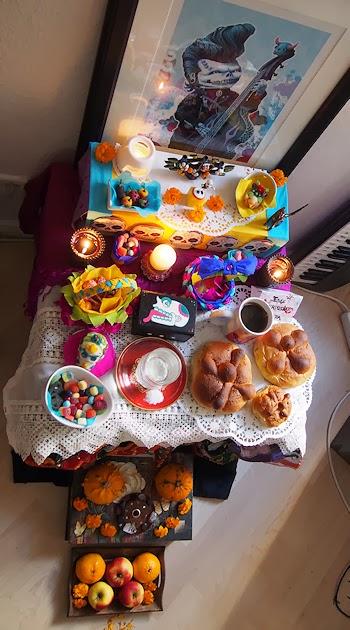
My Day of the Day altar - 2013 Edition, top view.
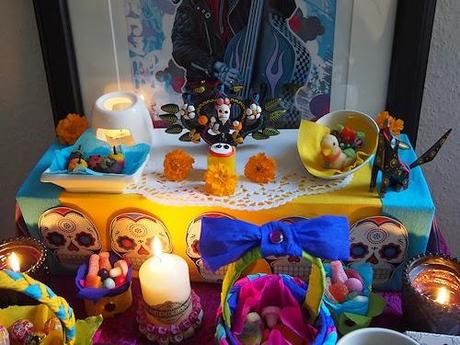
Candy, marzipan figurines, Day of the Dead memorabilia, little baskets with treats and candles.
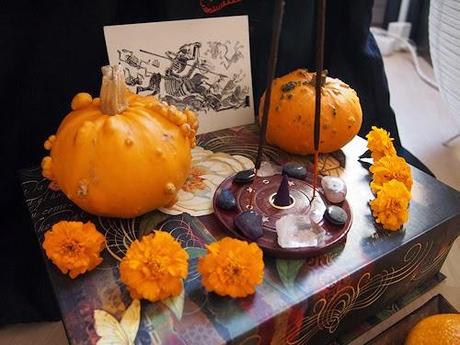
Detail of the bottom part: pumpkin, marigold and incense for the altar.
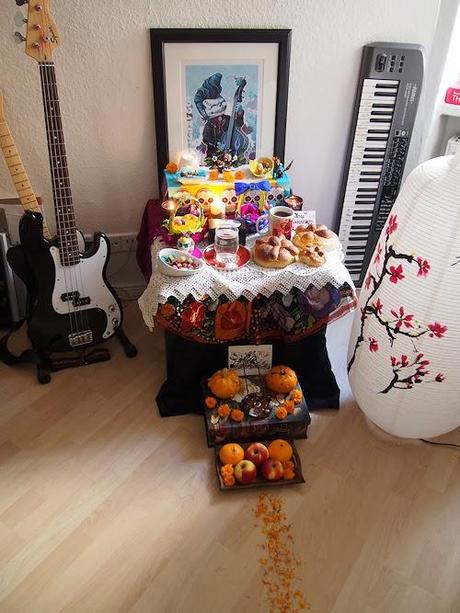
Don't forget the marigold petal trail to guide the visiting souls to the altar...
Once the altar has been set up, it is time to move into the next exciting phase of the operation: Food! The typical food prepared for the Day of the Dead celebration is in fact decorative by itself, and some of it is also very colorful and toy-like. However, there is also room for other more ‘normal’ dishes and additions.What kind of food is presented in a traditional Day of the Dead altar? Once more, the general principle is that everything goes, but the key elements that an altar should have are:
Day of the Dead Bread (Pan de Muerto).
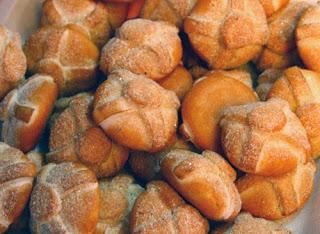
The first thing that springs to mind when thinking about day of the dead, for me, is the bread. It is a kind of sweet bread with a subtle but aromatic orange flavor and a touch of anis essence, and it’s only available during the days of the celebration, so you can only enjoy its delicious taste once a year, for a very limited time! (unless you decide to make your own, of course).
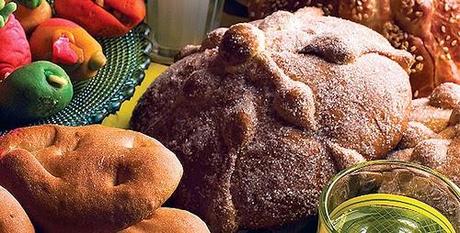
Day of the Dead bread often has a characteristic circular shape, with some puffy ornaments on top that are meant to resemble the bones of the deceased – creepy, huh? To take off the edge of the morbid detail, they are usually sprinkled with a generous amount of sugar or sesame seeds.
Given my German exile situation, I decided to make my own Day of the Dead bread. I followed a recipe I found on the net that sounded authentic (in Spanish, of course!), since the ones in English seemed to have some rather unorthodox additions or somehow didn’t feel like they would result in the flavor and texture I was looking for. To make a long story short, I ended up making way too much bread! But it was so fun, and I felt like a complete maniac once I had the oven full with over a dozen pieces of bread… I was definitely on a mission.
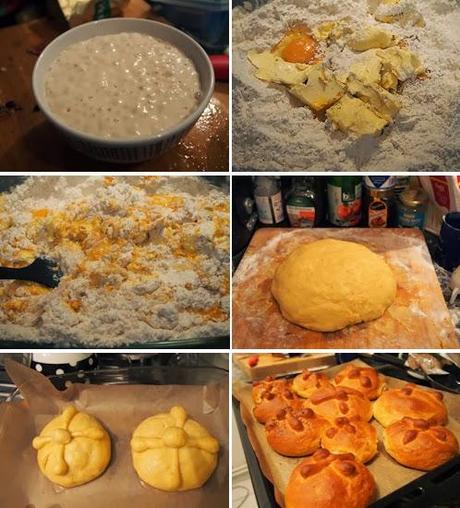
Graphic documentation of my Day of the Dead bread making Oddyssey.
Next time I would make a few modifications:1) Use more orange juice, but reduce it first by gently simmering it for some minutes so the water evaporates and the taste gets more concentrated.
2) Use less water for the yeast mixture. As the dough was a bit too runny, I had to add more flour, which took away some of the sweetness in the end. The texture was great, though!
Sugar Skulls.
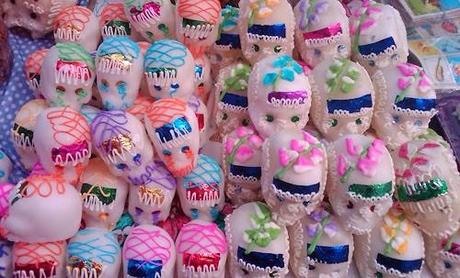
Sugar skulls: a sweet Mexican tradition.
The most iconic element in the Day of the Dead celebration, is definitely the sugar skull: a white cranium decorated with multicolored icing details, often sporting a metallic paper ‘headdress’ and usually bearing the name of one of the deceased loved ones being commemorated. While there is a standard basic design, the variations on color and decoration are endless; also, sugar is not the only ingredient they can be made of – chocolate, amaranth seeds and even gummy or candied fruit skulls are also popular and can be found at the markets.
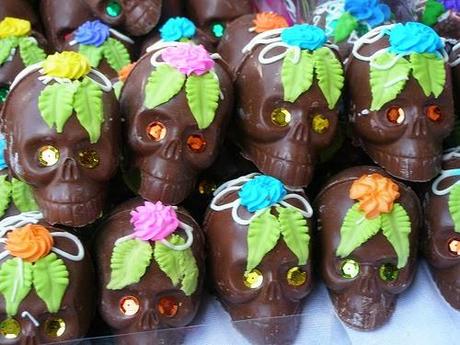
Day of the Dead chocolate skulls.
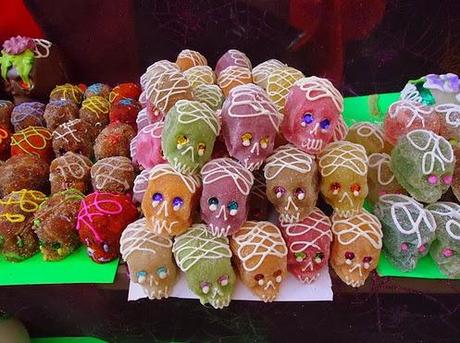
Colorful skulls made of candied fruit and gum.
One can make their own sugar skulls in a very fast and easy way, just by mixing 250 g of confectioner's sugar with 100 ml of condensed sweetened milk (the very dense variety); the ingredients are incorporated together until they make a paste that doesn't stick to the fingers anymore and is then ready to be shaped. Using a skull shaped mould makes it easier, since it takes a few hours for the mixture to dry up and solidify. Warning: using this sugar skull recipe, you'll find that the paste tastes like fudge, and you can suddenly find yourself eating it non-stop! Not that it happened to me, of course... To finish, take some bits of the mixture, dye them with vegetable colors (I used the ones that come as a gel, for easier handling) and carefully arrange the colorful icing as decoration over the skull. Place a couple of sequins on for the eyes, let it dry, and that's it!Marzipan Figurines (Figuritas de Jamoncillo).
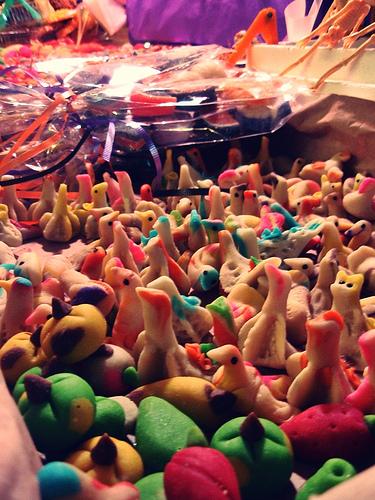
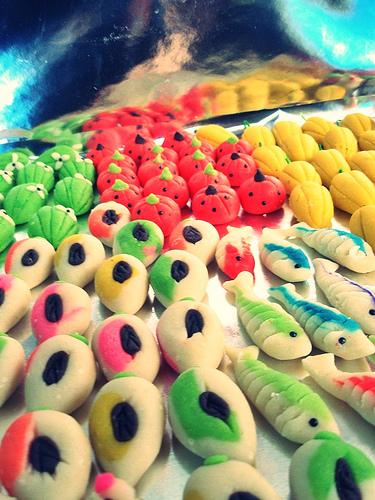
1) The lazy way: get a packet of good quality ready-made marzipan paste, like this:
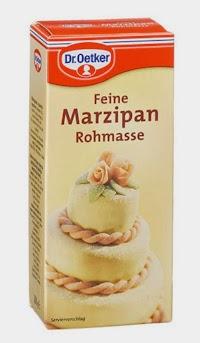
2) The slower, but more rewarding –and tastier– way: make it yourself! It’s easier than one would imagine.
The ingredients needed are: 1 cup finely chopped nuts (I like to combine almond and pine nuts together), ¼ cup milk and 1 cup condensed and sweetened milk (the really dense and sugary kind). Grind the nuts with the milk in a food processor; meanwhile, bring the condensed milk to a slow boil in a small pot, moving frequently so it won’t get burnt or stick to the bottom of the pot. Add the nut mixture to the hot condensed milk, and keep stirring until the whole paste gets thick enough so you can see the bottom of the pot when you stir the paste. Let it cool until it’s just a bit warm to touch, and then you can divide it into portions to be dyed in different colors, according to the figurines you want to model.
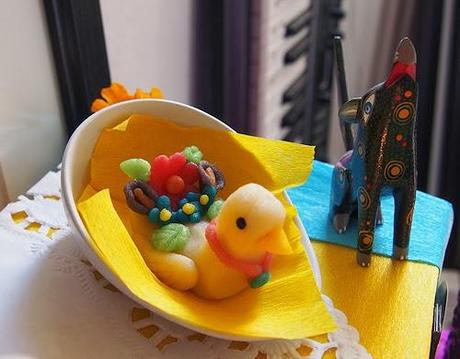
My own take on marzipan figures, inspired on the ones that can be found in my hometown during Day of the Dead.
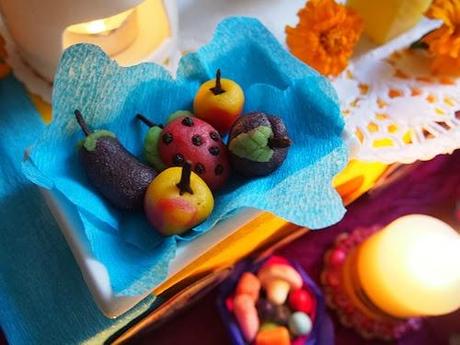
I made this little batch of marzipan fruit; I used cloves for the stems, and peppercorn grains for the strawberry details. It's all about getting creative!
Drinks.
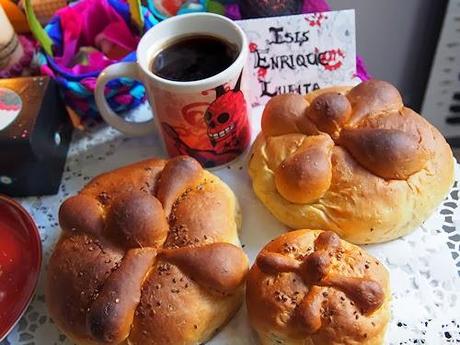
Coffee is good for the soul!
The altar must have a glass with water, as well as a pinch of salt; the souls of the dead use them to purify themselves when they come to the realm of the living – or so my grandma used to tell me. Besides water, it is traditional to offer the drink that the person being remembered enjoyed the most in life: coffee, hot chocolate or atole (a sweet corn dough-based drink) are the most popular options. Some people even serve bottles of Coke! Such is the soft drink addiction of the Mexican.
Small shots of liquor or sometimes whole bottles are also a common addition to an altar, to suit the taste of the deceased family members and friends being honored.
Traditional dishes: Mole, Tamales and Candied Pumpkin.
Not everything in the altar has to be sweet; most of the altars include some savory traditional Mexican dishes. Tamales and Mole are considered special celebration food, and therefore are often included here.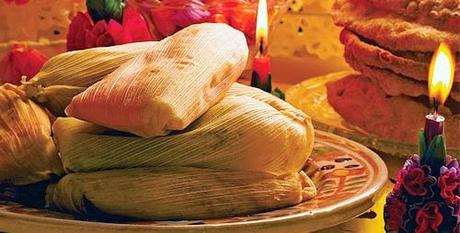
Delicious tamales waiting to be eaten by the living.
Tamales are a sort of steamed dumplings made of corn dough, and can be filled with a combination of vegetables, meat, cheese or beans. The possibilities are endless.
Mole is one of the boldest and most original creations in Mexican cuisine. It consists of a very thick sauce made of a crazily long combination of improbable ingredients, which include an assortment of chili peppers, toasted bread or crackers, banana, almonds and even chocolate! – all mixed into a dark, thick concoction. I know it sounds wacky, but the result is deliciously hearty and just slightly sweet. It is usually served with poultry and/or rice, sprinkled with sesame seeds.
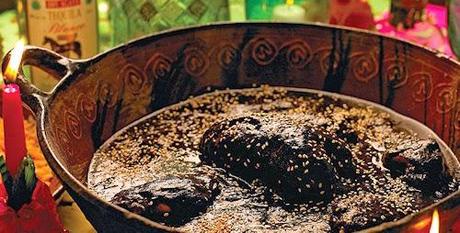
A nice pot of black Mole: a very traditional addition to the altar.
Another Day of the Dead staple is candied pumpkin, which is a sliced pumpkin slowly cooked in syrupy sauce made of unrefined sugar. It is delicious, but a sugar bomb!
Complements: Fruit and Candy.
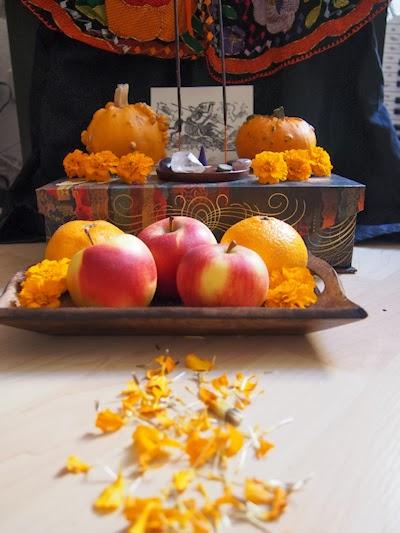
Pumpkins, apples and mandarin oranges are part of my offering this year.
Finally, as a complement for the main food offering, pieces of fruit and candy can be included. The pieces of fruit must be as beautiful and perfect as one can possibly find, and are usually seasonal fruit: mandarin oranges, apples and pears. The candy is also important for the celebration on the 31st of October, when children’s souls visit the living during the festivities; be sure to offer plenty of treats for them to enjoy!
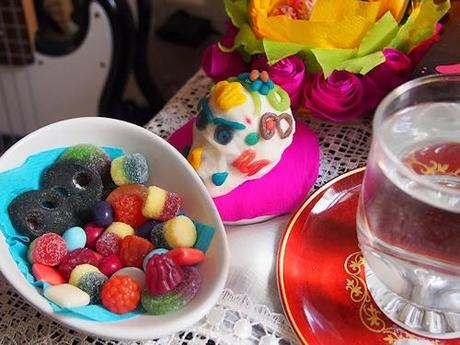
Colorful sweet treats for the little ones in my Day of the Dead altar.
The celebration has started traditionally since the 28th of October. However, there are still a few days to go until the main event: the day of All Saints on the night of November 1st and the main Day of the Dead festivity, happening this weekend on November 2nd. Stay tuned so we can celebrate together! Thank you for reading!